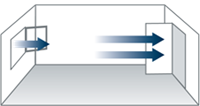Window ventilation
Window ventilation is the easiest and quickest way to replace the air in the room, regulate humidity and reduce the risk of mould growth. There are three possible ways of doing this:
|

|

|

|
|
Tilting windows
|
Purge ventilation |
Cross ventilation
|
Tilting windows / Ventilation by tilting windows is not recommended with today’s thermal insulation standards, especially in winter and in wet-rooms. The windows are tilted to let natural air flow in. This method of ventilation is not recommended, especially over a prolonged period of time. This is because when doing so, the window reveal cools down excessively and there is an increased risk of condensation water and thus mould growth at the reveals.
Purge ventilation / The window sashes are opened wide for a short period (4 – 10 minutes). This enables a fast exchange of air, energy losses are minimised.
Cross ventilation / Cross ventilation is the most effective way to ventilate a room. To do this, windows and doors are opened to create a draught and this leads to the entire amount of air being exchanged within 2 – 4 minutes.
Since 2009 the
DIN 1946-6 stipulates that all new buildings must have a ventilation concept. In renovation projects a ventilation concept also has to be provided if, in detached family houses and apartment houses, more than a 3rd of all windows are replaced or a new roof insulation is provided over more than 1/3 of the roof area. You will find more detailed information on the ventilation standard on our
Info Page DIN 1946-6.
You will find more detailed information on the relationship of humidity and mould growth on our
Info Page Humidity in living areas.
You can download our tips on window ventilation as pdf-file here.